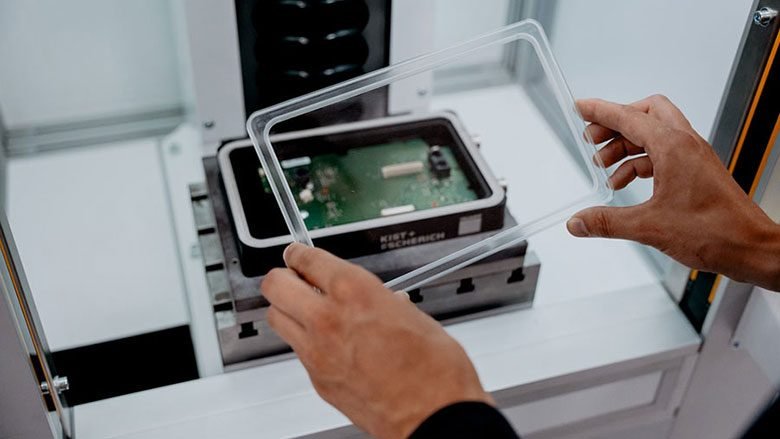Engineers have many options for joining plastic parts to plastic parts or metal parts to metal parts. However, when joining plastic parts to metal parts, engineers have fewer choices.
Now, German company Kist + Escherich has developed an innovative new process, HyJoin, that can join plastic parts to metals without adhesives or fasteners.
The HyJoin process can be used to create both spot joints and media-tight seam joints.
The process can be used on a variety of thermoplastics, including polyamide, polypropylene, polyethylene, polyphenylene sulfide, polyaryletherketone, polyoxymethylene, polycarbonate and thermoplastic polyurethane. The plastic can be unreinforced or reinforced with short or continuous glass or carbon fibers.
The metal component can be aluminum, steel, titanium, magnesium or copper. It can be extruded, cast, sintered or additively manufactured. It can be coated or uncoated. However, for the process to work, the area to be joined on the metal part must get an ablative pretreatment to roughen its surface.
To start the HyJoin process, the metal part is selectively heated in the joining area through electromagnetic induction. Embedded in the upper joining die, the inductive coil is energized by a high-frequency alternating current. Simulations and laboratory tests are used to optimize the design of the coil.
Subsequently or simultaneously during heating, the plastic part is pressed together with the metal part. The plastic reaches the glass transition temperature and melts at the contact area, flowing into microscopic nooks and crevices created in the metal part by the ablative pretreatment. After cooling, the plastic solidifies and becomes mechanically interlocked with the metal part.

Prior to assembly, the surface of the metal part must be roughened. To start, the metal part is selectively heated through electromagnetic induction. Next, the plastic part is pressed together with the metal part. The plastic melts at the contact area, flowing into microscopic crevices in the metal part. After cooling, the plastic solidifies and becomes mechanically interlocked with the metal part. Photo courtesy Kist + Escherich
The key parameters of the process are joining force, collapse distance, heating power and heating time.
HyJoin creates assemblies with lasting stability and high load-bearing capacity. Joints created through the process are comparable in strength to those created with structural adhesives. Unlike adhesive bonding, however, the HyJoin process is easily automated and only takes a few seconds. In addition, integrated force and stroke monitoring makes accurate process control possible, enabling the system to compensate for component tolerances and minimize joining times.
Another advantage of the HyJoin process is its reversibility. The connection can be undone with little damage to the parts, which makes for easy repairs or recycling of materials at the end of their service life.
The flexible process can be used on small assemblies or large, complex structures. Applications abound in the automotive, electronics, appliance and medical device manufacturing industries.
Electrical equipment manufacturer Conductix-Wampfler is using the HyJoin system to connect copper-graphite sliding contacts with plastic insulation. The fully automated process assembles a sliding contact every 10 seconds. A six-axis robot loads parts from trays into fixtures around a rotary-indexing dial. After assembly, the parts are cooled and tested before a second robot unloads them.
Another application is actively cooled plastic housings for energy storage, sensors or electronics. In this application, the HyJoin process is used to join a metallic heat sink with a plastic part. This obviates the need for screws or gaskets in the assembly. It also lets engineers reduce the width of the joining flange and therefore make the design more compact. At the end of the product’s life cycle, the connection can be thermally separated for recycling.

GiroJoin is a preconfigured automated assembly cell equipped with a rotary indexing table. Parts can be loaded manually or robotically. Photo courtesy Kist + Escherich
Equipment Options
Compact and modular, the HyJoin system can be operated as a standalone, semiautomatic process, or it can be integrated into an automated assembly line.
The main joining module is available in two versions: one with a maximum pressing force of 5 kilonewtons and the other with a maximum force of 10 kilonewtons. Maximum stroke length is 200 millimeters, and ram speed peaks at 100 millimeters per second.
By itself, the module can join parts as large as 150 by 150 millimeters. Kist + Escherich also offers the module in a preconfigured, semiautomatic workstation, the VarioJoin, that can join assemblies as large as 300 by 200 by 300 millimeters.
Another option is GiroJoin, a preconfigured automated assembly cell equipped with a rotary indexing table. Parts can be loaded manually or robotically.
GiroJoin is available in two sizes. A cell with a table 600 millimeters in diameter can accommodate four stations and assemblies as large as 80 by 150 millimeters. A cell with a table 900 millimeters in diameter can accommodate six stations and assemblies as large as 150 by 200 millimeters.
Optional equipment for VarioJoin and GiroJoin includes:
- Sensors to detect when parts are present.
- A controller that can store multiple process “recipes.”
- A process monitoring system for quality assurance.
- An interface to link the machine with MES software.
For more information on the HyJoin process, click www.kist-escherich.com.

The key parameters of the HyJoin process are joining force, collapse distance, heating power and heating time. Photo courtesy Kist + Escherich
For more information on mixed-material assembly methods, read these articles:
New Process Enables Adhesive-Free Joining of Metal and Wood
New Techniques for Joining Plastic to Metal
New Techniques for Joining Steel and Aluminum

